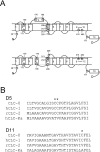Elimination of the slow gating of ClC-0 chloride channel by a point mutation
- PMID: 10398688
- PMCID: PMC2229640
- DOI: 10.1085/jgp.114.1.1
Elimination of the slow gating of ClC-0 chloride channel by a point mutation
Abstract
The inactivation of the ClC-0 chloride channel is very temperature sensitive and is greatly facilitated by the binding of a zinc ion (Zn2+) from the extracellular side, leading to a Zn2+-induced current inhibition. To further explore the relation of Zn2+ inhibition and the ClC-0 inactivation, we mutated all 12 cysteine amino acids in the channel and assayed the effect of Zn2+ on these mutants. With this approach, we found that C212 appears to be important for the sensitivity of the Zn2+ inhibition. Upon mutating C212 to serine or alanine, the inactivation of the channel in macroscopic current recordings disappears and the channel does not show detectable inactivation events at the single-channel level. At the same time, the channel's sensitivity to Zn2+ inhibition is also greatly reduced. The other two cysteine mutants, C213G and C480S, as well as a previously identified mutant, S123T, also affect the inactivation of the channel to some degree, but the temperature-dependent inactivation process is still present, likewise the high sensitivity of the Zn2+ inhibition. These results further support the assertion that the inhibition of Zn2+ on ClC-0 is indeed due to an effect on the inactivation of the channel. The absence of inactivation in C212S mutants may provide a better defined system to study the fast gating and the ion permeation of ClC-0.
Figures










Similar articles
-
Oxidation and reduction control of the inactivation gating of Torpedo ClC-0 chloride channels.Biophys J. 2005 Jun;88(6):3936-45. doi: 10.1529/biophysj.104.055012. Epub 2005 Mar 18. Biophys J. 2005. PMID: 15778445 Free PMC article.
-
Extracellular zinc ion inhibits ClC-0 chloride channels by facilitating slow gating.J Gen Physiol. 1998 Dec;112(6):715-26. doi: 10.1085/jgp.112.6.715. J Gen Physiol. 1998. PMID: 9834141 Free PMC article.
-
Zinc inhibits human ClC-1 muscle chloride channel by interacting with its common gating mechanism.J Physiol. 2005 Oct 1;568(Pt 1):5-12. doi: 10.1113/jphysiol.2005.091777. Epub 2005 Jul 7. J Physiol. 2005. PMID: 16002443 Free PMC article.
-
Properties of voltage-gated chloride channels of the ClC gene family.J Physiol. 1995 Jan;482(P):19S-25S. doi: 10.1113/jphysiol.1995.sp020560. J Physiol. 1995. PMID: 7730971 Free PMC article. Review.
-
Coupling gating with ion permeation in ClC channels.Sci STKE. 2003 Jun 24;2003(188):pe23. doi: 10.1126/stke.2003.188.pe23. Sci STKE. 2003. PMID: 12824475 Review.
Cited by
-
Anion pathway and potential energy profiles along curvilinear bacterial ClC Cl- pores: electrostatic effects of charged residues.Biophys J. 2004 Feb;86(2):825-35. doi: 10.1016/S0006-3495(04)74158-2. Biophys J. 2004. PMID: 14747318 Free PMC article.
-
Barttin activates ClC-K channel function by modulating gating.J Am Soc Nephrol. 2010 Aug;21(8):1281-9. doi: 10.1681/ASN.2009121274. Epub 2010 Jun 10. J Am Soc Nephrol. 2010. PMID: 20538786 Free PMC article.
-
The role of a conserved lysine in chloride- and voltage-dependent ClC-0 fast gating.J Gen Physiol. 2007 Oct;130(4):351-63. doi: 10.1085/jgp.200709760. Epub 2007 Sep 10. J Gen Physiol. 2007. PMID: 17846165 Free PMC article.
-
Conformational changes in the pore of CLC-0.J Gen Physiol. 2003 Sep;122(3):277-93. doi: 10.1085/jgp.200308834. Epub 2003 Aug 11. J Gen Physiol. 2003. PMID: 12913090 Free PMC article.
-
Dissecting a regulatory calcium-binding site of CLC-K kidney chloride channels.J Gen Physiol. 2012 Dec;140(6):681-96. doi: 10.1085/jgp.201210878. Epub 2012 Nov 12. J Gen Physiol. 2012. PMID: 23148261 Free PMC article.
References
-
- Backx P.H., Yue D.T., Lawrence J.H., Marban E., Tomaselli G.F. Molecular localization of an ion-binding site within the pore of mammalian sodium channels. Science. 1992;257:248–251. - PubMed
-
- Fahlke Ch., Yu H.T., Beck C.L., Rhodes T.H., George A.L., Jr. Pore-forming segments in voltage-gated chloride channels. Nature. 1997;390:529–532. - PubMed
-
- Fersht, A. 1985. The structures and mechanisms of selected enzymes. In Enzyme Structure and Mechanism, 2nd ed. W.H. Freeman and Co., New York. 389–452.

